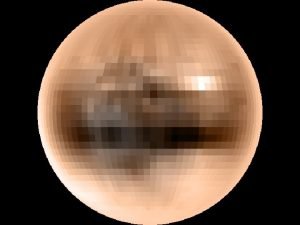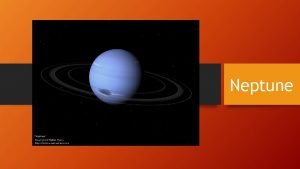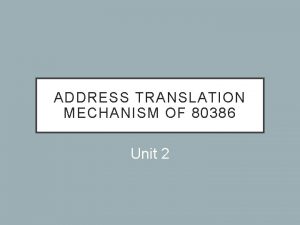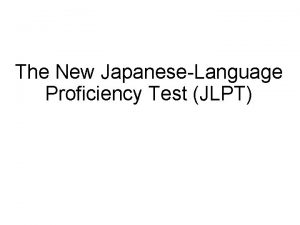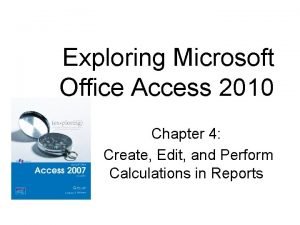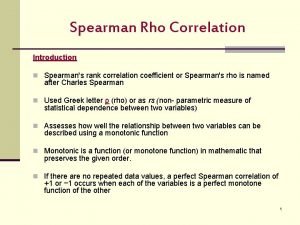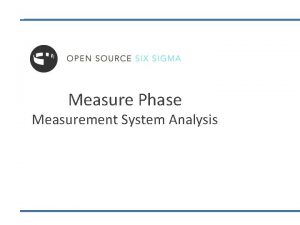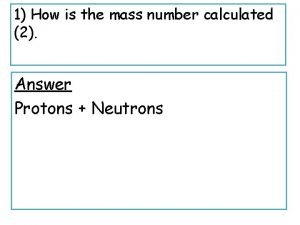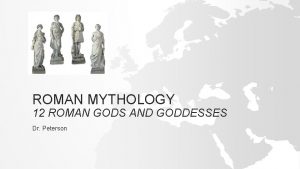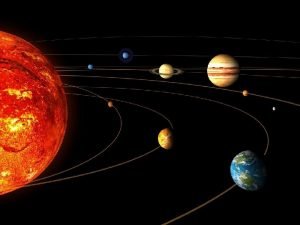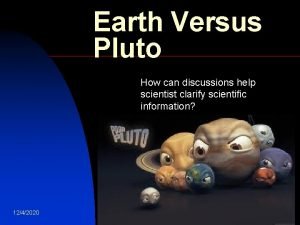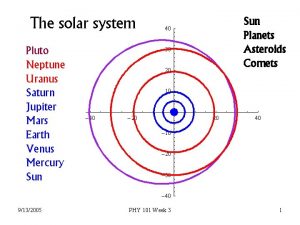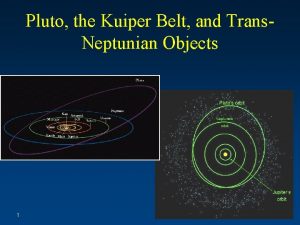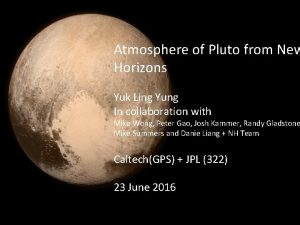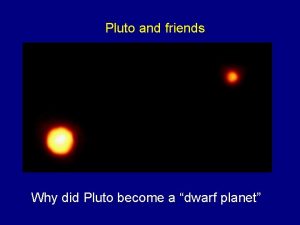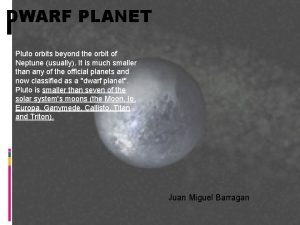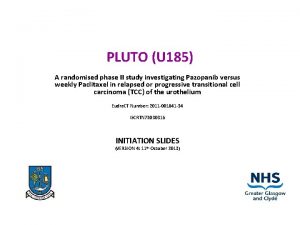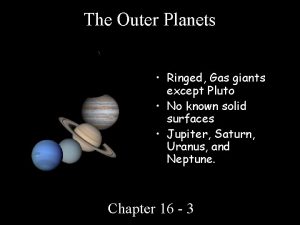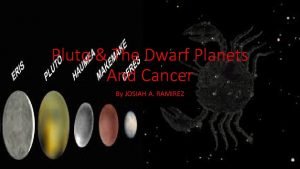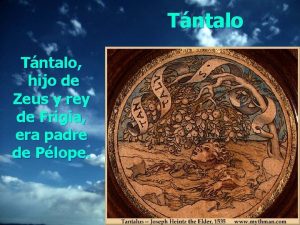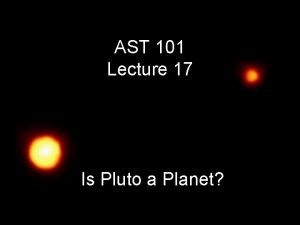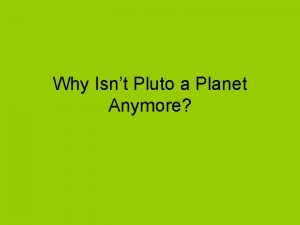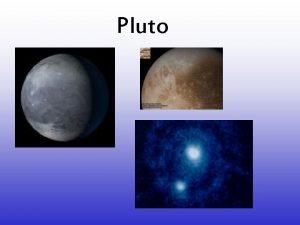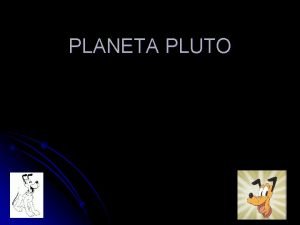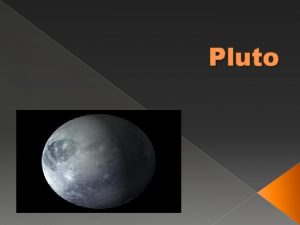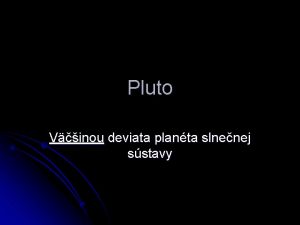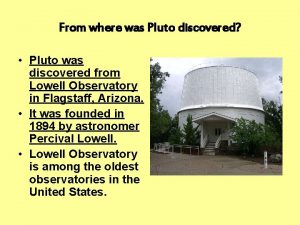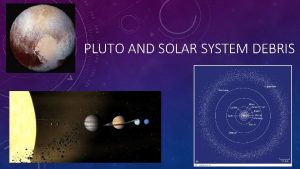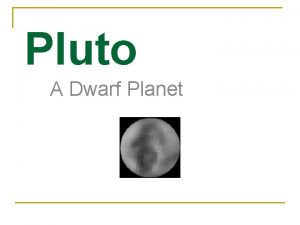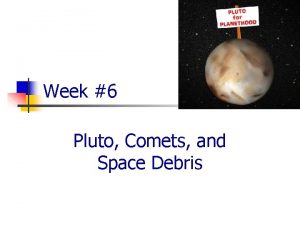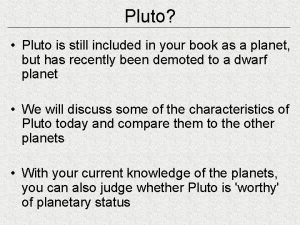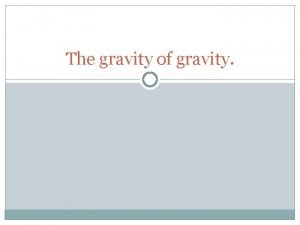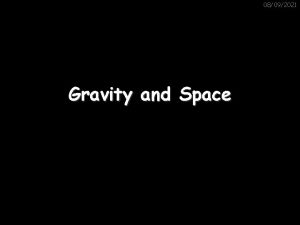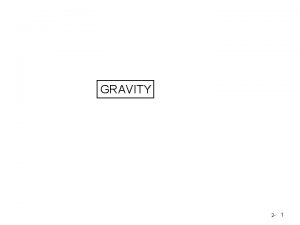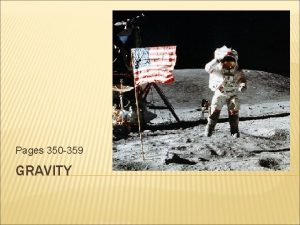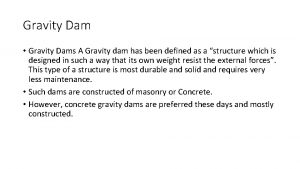Pluto Scientists calculated that Neptunes gravity was not


































































- Slides: 66




Pluto Scientists calculated that Neptune’s gravity was not enough to cause all of the irregularities of Uranus’ orbit.

They also found that something else was perturbing Neptune’s orbit.

Percival Lowell calculated the probable location of this third body and searched for it in the decade prior to his death in 1916. He never found “planet X”.

In 1930 Clyde Tombaugh found the planet only 6° away from Lowell’s predicted location. He announced his discovery on March 13, 1930. (March 13 was Lowell’s birthday)




Neil de. Grasse Tyson with Clyde Tombaugh’s Wife

These are the actual photos Clyde Tombaugh used to locate Pluto.


Actually Pluto is too small to cause the perturbations calculated for Uranus and Neptune. Also, these calculations were later found to be in error, so the discovery of Pluto was nothing more than “dumb luck”.

Pluto in bulk: Semi-major axis: 39. 5 A. U. Eccentricity: 0. 25 (very large)

Pluto’s orbit is inclined 17. 2° to the ecliptic, more than any other planet. Pluto’s orbital period is 248. 6 years (1. 5 times Neptune’s).


Pluto’s orbital path carries it inside the orbit of Neptune at perihelion. So, at times, Pluto is the eighth planet from the Sun rather than the ninth, as it was from 1979 to 1999.


Pluto has five known moons, Charon was the first one discovered. The other four, Nix, Hydra, Kerberos, and Styx have been discovered







Charon’s orbit is inclined 118° to Pluto’s orbital plane, so Charon orbits at a right angle to Pluto’s orbit around the Sun.


Pluto’s rotation angle is tilted at 120°, so the moon still orbits over the equator of Pluto.


Charon’s orbital period was used to find the mass of Pluto. Charon’s orbit was lined up such that there were a series of Charon-Pluto eclipses from 1985 to 1991. (This only happens once every 124 years. )


These eclipses helped astronomers to find the mass, radii and other information about Pluto and Charon.

Pluto’s mass is 0. 0025 Earth masses. Remember, Earth is one of the smaller planets; so, in size, Pluto is more like a moon than a planet.


Pluto is smaller than seven solar system moons: Earth’s Moon plus the moons Io, Europa, Ganymede, Callisto, Titan, and Triton.


Pluto’s diameter is 2300 km. (one-fifth that of Earth) Charon’s diameter is 1300 km. This is over half the diameter of Pluto.



Pluto and Charon are tidally locked. The same side of Charon always faces Pluto, and the same side of Pluto always faces Charon.


Charon’s orbital period is 6. 4 Earth days.

Charon’s mass is about one -sixth that of Pluto. Were Pluto still a planet, that would be the largest satellite to planet ratio in the solar system. Now that “honor” belongs the Earth and Luna.

Pluto is similar in mass and radius (and; therefore, probably in composition) to the Neptunian moon Triton.

Pluto has a high albedo, 0. 6, which aided in its detection.

Frozen CH 4 is a major surface constituent. Pluto is the only planet cold enough to have solid CH 4.

Pluto is so different from the Jovian planets and is so much like the moons of these planets, it was thought to be an escaped moon of one of the gas giants.

This was a good explanation, until Charon was found. It is unlikely that two “lost” moons would come together to form the Pluto-Charon system.

There may have been lots of ice chunks like Pluto orbiting the Sun at one time. Many of them eventually captured to form Jovian moons while another formed Charon. But, all of this is just speculation.

Pluto was removed as a planet when the definition of a planet was officially defined. A planet must: (1) orbit the Sun, (2) be large enough to be formed into a sphere by gravity, and:

(3) it must have enough gravity to clear its orbit of other large objects. Pluto fails to meet this last qualification.

Many trans-Neptunian objects have been found at orbits beyond Neptune’s. One, Eris, is actually larger than Pluto.

The discovery of Eris was the last straw in the reassignment of Pluto to dwarf planet status. (One asteroid, Ceres, is also considered a dwarf planet. )











New Horizons launched in 2006, scheduled to arrive at Pluto in July, 2015.

 What is neptunes gravity
What is neptunes gravity How is specific gravity calculated
How is specific gravity calculated How much moons dose neptune have
How much moons dose neptune have Gravity for dummies and dummies for gravity equations
Gravity for dummies and dummies for gravity equations Thơ thất ngôn tứ tuyệt đường luật
Thơ thất ngôn tứ tuyệt đường luật Tôn thất thuyết là ai
Tôn thất thuyết là ai Ngoại tâm thu thất chùm đôi
Ngoại tâm thu thất chùm đôi Chiến lược kinh doanh quốc tế của walmart
Chiến lược kinh doanh quốc tế của walmart Gây tê cơ vuông thắt lưng
Gây tê cơ vuông thắt lưng Block xoang nhĩ độ 2 type 1
Block xoang nhĩ độ 2 type 1 Tìm vết của mặt phẳng
Tìm vết của mặt phẳng Sau thất bại ở hồ điển triệt
Sau thất bại ở hồ điển triệt Thể thơ truyền thống
Thể thơ truyền thống Hãy nói thật ít để làm được nhiều
Hãy nói thật ít để làm được nhiều Sadlier vocabulary workshop level d unit 1 synonyms
Sadlier vocabulary workshop level d unit 1 synonyms Howto calculate gdp
Howto calculate gdp Capacity flow
Capacity flow Explain protection mechanism of 80386 with diagram.
Explain protection mechanism of 80386 with diagram. Buept max score
Buept max score Marginal rate of substitution of x for y is calculated as
Marginal rate of substitution of x for y is calculated as Array types in c++
Array types in c++ Scentsy how do you know the hostess
Scentsy how do you know the hostess Calculate mlu
Calculate mlu Short working is the
Short working is the Bound unbound and calculated controls
Bound unbound and calculated controls Vcaa statement of results
Vcaa statement of results How to calculate map scale
How to calculate map scale Spearman rank correlation formula for repeated ranks
Spearman rank correlation formula for repeated ranks Calculation of stroke volume
Calculation of stroke volume How is gdp calculated
How is gdp calculated Compressive strength of concrete
Compressive strength of concrete The criterion is calculated as pvncf / ninv
The criterion is calculated as pvncf / ninv Leave encashment calculation
Leave encashment calculation Calculating retained earnings
Calculating retained earnings Khosla formula for runoff
Khosla formula for runoff Sle aro ale examples
Sle aro ale examples How to determine total cholesterol
How to determine total cholesterol Roi can be calculated as ______.
Roi can be calculated as ______. Work is calculated by multiplying
Work is calculated by multiplying Calculated field access 2007
Calculated field access 2007 Marginal rate of substitution of x for y is calculated as
Marginal rate of substitution of x for y is calculated as Measurement system analysis adalah
Measurement system analysis adalah Calculated control access
Calculated control access How is mass number calculated
How is mass number calculated When mr adams calculated his students
When mr adams calculated his students Daly calculation
Daly calculation Mercury god name
Mercury god name The solar system
The solar system Pluto planta
Pluto planta 9.34.t - lesson: uranus, neptune & pluto assessment
9.34.t - lesson: uranus, neptune & pluto assessment One revolution is the same as: phy101
One revolution is the same as: phy101 Makemake
Makemake Pluto planta
Pluto planta Pluto plus github
Pluto plus github Pluto planta
Pluto planta Pluto planta
Pluto planta Dwarf planet symbols
Dwarf planet symbols Pluto trial
Pluto trial Inside pluto planet
Inside pluto planet Pluto planta
Pluto planta Pluto planta
Pluto planta Pluto planta
Pluto planta Hijo de pluto rey de frigia
Hijo de pluto rey de frigia Pluto planta
Pluto planta The god of agriculture
The god of agriculture Pluto's atmosphere
Pluto's atmosphere Why isn't pluto a planet anymore
Why isn't pluto a planet anymore
